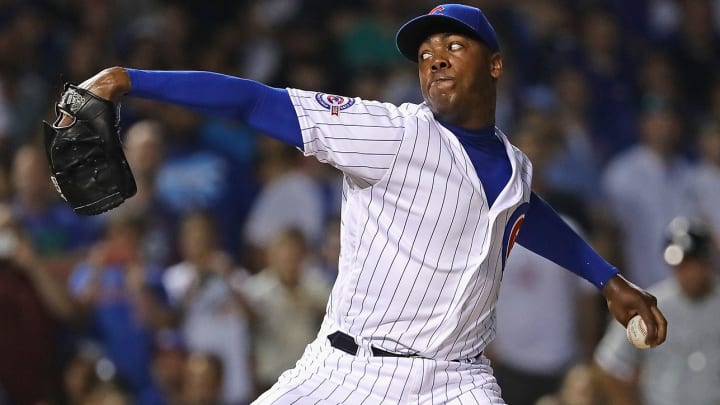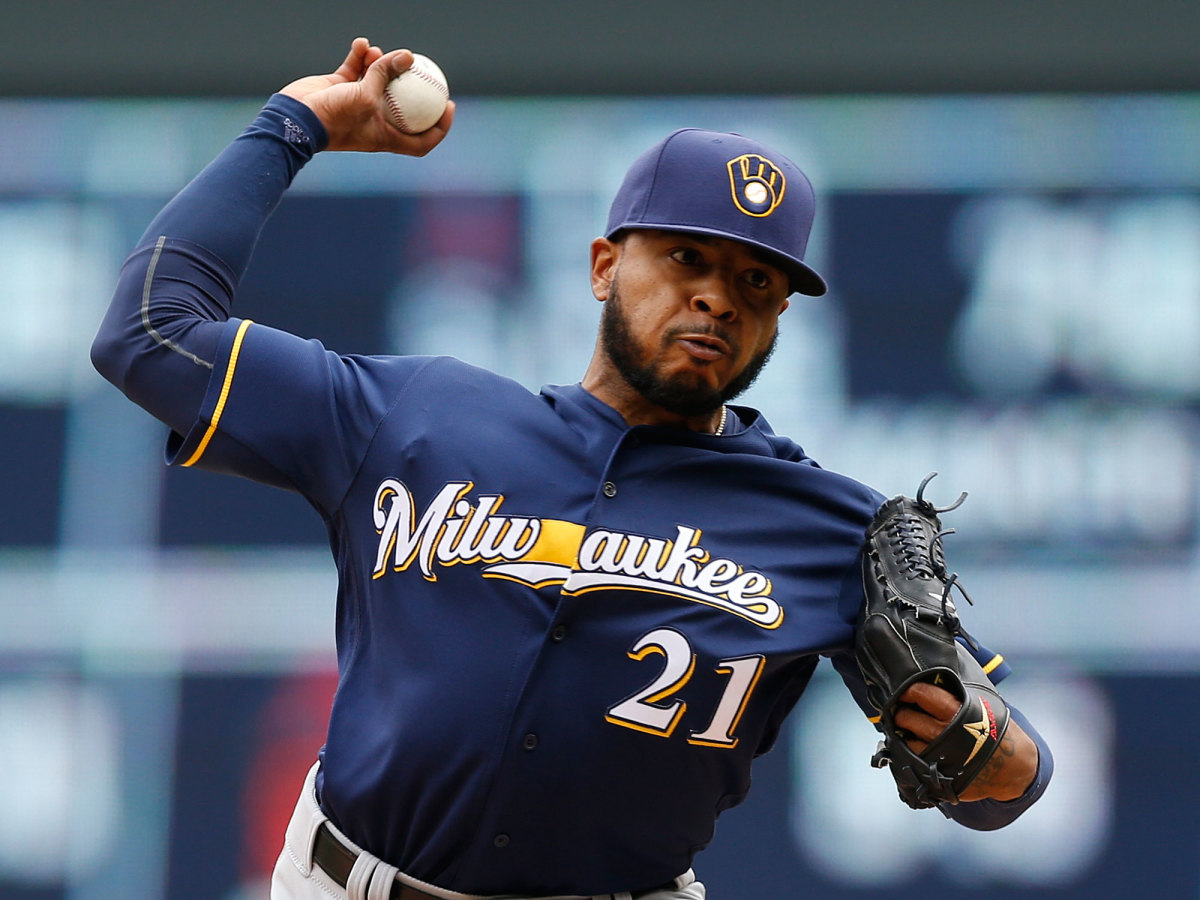Trades by Cubs, Nationals, Indians, Rangers show they're all in to end droughts

The minimum speed limit on the road to nirvana is 95 mph. Such is the lesson from trade deadline season, when the four teams and cities with the longest World Series droughts continued to spin off bits of their future to grab as much velocity as possible at the end of postseason games.
The Cubs (108 years since their last championship), Nationals (92 years for the district), Indians (68 years) and Rangers (never in their 56-year history), in baseball’s version of a weird planetary alignment, all made it to the deadline in first place. All made key moves to beef up their bullpen in advance of the deadline. All will enter the pennant push with a different closer than when they started the season. All willingly paid high prices to do so.
But only one of them, at most, ultimately can be right.
The price of relief has gone sky high, reflecting the emphasis modern metrics and the increasing supply of power arms have put on the game. And when you’re talking 324 combined years of waiting, the Cubs, Nationals, Indians and Rangers imagined the kind of pitcher they would need to get historic outs in the World Series, and none felt comfortable with what they had.
But that’s the inner beauty of this baseball season. This is a year of long-awaited opportunity. Five first-place teams and one wild card team have not won the World Series in at least a quarter of a century. For them, it’s not just about getting to the postseason or extending the overwrought “window” people love to talk about or, goodness no, bragging about how many top-100 prospects they were holding. It’s about taking a shot at true history.
As Cubs president Theo Epstein said after he overpaid for closer Aroldis Chapman: “If not now, when?”
Trade deadline winners and losers: Rangers, Yankees come out on top
In the days leading up to the deadline, Epstein grabbed Chapman—the hardest-thrower in baseball at 100 mph on average—as well as Mike Montgomery and Joe Smith to supplement erstwhile closer Hector Rondon, who throws 96, in the 'pen. The Nationals traded for Mark Melancon, who throws a 92-mph cutter. The Indians went big with Andrew Miller, who throws 94 and strikes out 15.3 batters per nine innings. The Rangers added Jeremy Jeffress (who throws 96) to Jake Diekman (who throws 95), Sam Dyson (who throws 96) and Matt Bush (who throws 97).
Even the Giants, who won championships in 2010, '12 and '14 with a matchup, finesse bullpen, jumped into the relief-pitching arms race. They traded a top pitching prospect and a possible everyday catcher to the Brewers get a setup reliever with two career saves, Will Smith, who just happens to punch out 9.9 batters per nine innings in his career.

The starting pitching market was Dullsville. Matt Moore, going from Tampa Bay to San Francisco, might be the only traded starter who starts a postseason game, unless you believe Dodgers addition Rich Hill can stay healthy. The rest of it was filler (the Marlins' Andrew Cashner, the Rangers' Lucas Harrell, the Orioles' Wade Miley, the Dodgers' Bud Norris, the Pirates' Ivan Nova and the Red Sox' Drew Pomeranz).
The Dodgers, by the way, who haven’t won it all since 1988, just happen to have the best bullpen in baseball (3.03 ERA). They're followed by the Nationals (3.05), who play in a city that hasn’t seen a World Series champion since the 1924 Senators, and the Orioles (3.06), who haven’t won the title since 1983. Last year, the World Series-winning Royals ranked No. 2 in bullpen ERA.
Think about how quickly this heavy value on strikeout bullpens has grown. At the 2014 deadline, Baltimore traded Eduardo Rodriguez, its No. 4 prospect, to Boston to get Miller. Last year, Washington traded its 10th-best prospect, 22-year-old pitcher Nick Pivetta, to Philadelphia to get Jonathan Papelbon, who at the time was 17 for 17 in saves with a 1.59 ERA. This year, the Cubs gave up a top-30 overall prospect, Gleyber Torres; an established major league pitcher, Adam Warren; and two other players to the Yankees just to rent Chapman for two months.
• Subscribe to get the best of Sports Illustrated delivered right to your inbox
If the 2015 Royals didn’t invent this trend, they certainly popularized it. Kansas City won the World Series with a rotation that was next-to-last in the league in the regular season in innings pitched. In the postseason, its starters went 3–5; its relievers went 8–0. The Royals turned the tenets of baseball upside down. Somewhere, Sandy Koufax wept because of what had happened to October.
The Royals had waited 30 years for their moment. Kansas City became a true baseball town again. Attendance, ratings and merchandise have skyrocketed. A crowd twice the size of the city’s population jammed downtown Kansas City to bask in the team's championship parade.
When you win in a place where generations of fans have never seen a World Series championship and people are lusting to buy a hat, hoodie or T-shirt that says “World Champions,” you’re talking about something bigger than just flying a flag. You’re talking about a milestone marker in people’s lives—a cultural shift. That is what a World Series title would mean for the Cubs, Nationals, Indians or Rangers. The first-place Orioles (33 years), the wild-card chasing Tigers (32 years) and Mets (30 years) and the wild-card leading Dodgers (28 years) are kindred younger brothers in patience.
Trade deadline roundup: Analyzing the day’s smaller deals
Some of this deep yearning has helped fuel another trend: Teams have stopped treating their prospects like gold. The cottage industry of rating prospects and the cover general managers give themselves by talking up their farm system have lost some value in this age of Going For It. Four of the first 18 picks in the draft last year already have been traded (Dansby Swanson, Dillon Tate, Josh Naylor and Phil Bickford, the latter of whom went from San Francisco to Milwaukee on Monday), as well as four of the first 18 from the year before (Trea Turner, Sean Newcombe, Touki Toussaint and Brandon Finnegan).
Everybody gets talked up like they're the next Clayton Kershaw or Mike Trout, because who doesn’t want to dream on youth? According to a 2013 study by Baseball America, however, 60% of first-round picks fail to log three years of regular contribution in the big leagues, and that’s not including first-round supplemental picks.
Maybe this year's World Series championship was won at the trading deadline. Maybe it was lost. We have no way of knowing until History reveals her finely crafted script. What we do know is that the Cubs, Nationals, Indians and Rangers have bought all in on the idea of an über-bullpen for October. They have seized an opportunity and are willing to pay its high price. Welcome to the year of Going For It.
